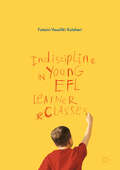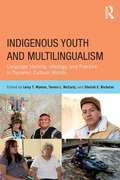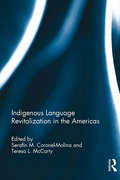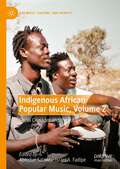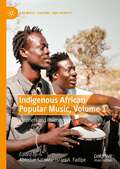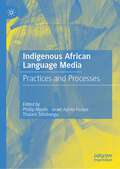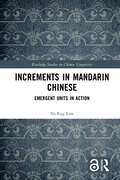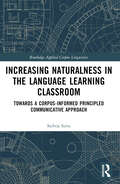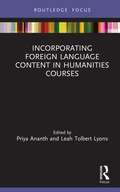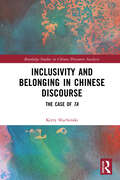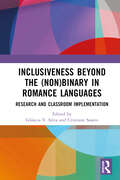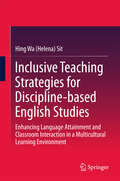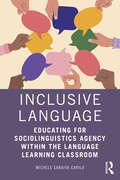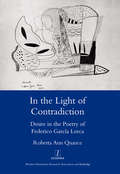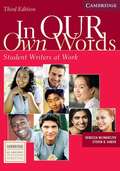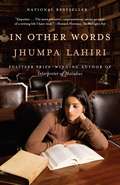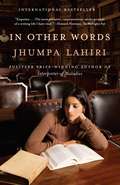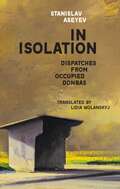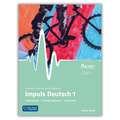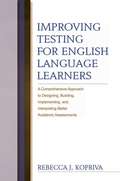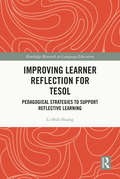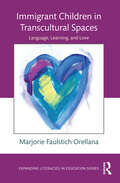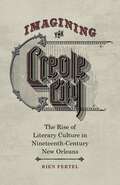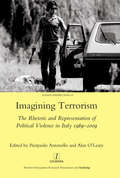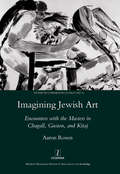- Table View
- List View
Indiscipline in Young EFL Learner Classes
by Foteini-Vassiliki KuloheriThis book sheds new light on classroom indiscipline by listening to the voices of both the teachers and the young learners of English as a Foreign Language (EFL). By focusing on data from multiple sources, chapters in this volume offer a thorough description of undisciplined learner acts, a framework for categorizing indiscipline types, an exploration of perceived causality beyond the observable behavior, and of management strategies and their evaluation by teachers and children. The author offers practical guidance on creating a disciplined EFL learning classroom atmosphere through multilateral educational aims and processes. This book is a point of reference for academics, researchers, university students, educators and teacher trainers who wish to enhance the design and implementation of reliable multi-lens qualitative case studies on the subject. With its elucidating and transformative power, it inspires further innovative research and practical initiatives for the understanding and successful management of child indiscipline in diverse EFL learning contexts.
Indigenous Youth and Multilingualism: Language Identity, Ideology, and Practice in Dynamic Cultural Worlds
by Teresa L. McCarty Leisy T. Wyman Sheilah E. NicholasBridging the fields of youth studies and language planning and policy, this book takes a close, nuanced look at Indigenous youth bi/multilingualism across diverse cultural and linguistic settings, drawing out comparisons, contrasts, and important implications for language planning and policy and for projects designed to curtail language loss. Indigenous and non-Indigenous scholars with longstanding ties to language planning efforts in diverse Indigenous communities examine language policy and planning as de facto and de jure – as covert and overt, bottom-up and top-down. This approach illuminates crosscutting themes of language identity and ideology, cultural conflict, and linguistic human rights as youth negotiate these issues within rapidly changing sociolinguistic contexts. A distinctive feature of the book is its chapters and commentaries by Indigenous scholars writing about their own communities. This landmark volume stands alone in offering a look at diverse Indigenous youth in multiple endangered language communities, new theoretical, empirical, and methodological insights, and lessons for intergenerational language planning in dynamic sociocultural contexts.
Indigenous Language Revitalization in the Americas
by Serafín M. Coronel-Molina Teresa L. McCartyFocusing on the Americas – home to 40 to 50 million Indigenous people – this book explores the history and current state of Indigenous language revitalization across this vast region. Complementary chapters on the USA and Canada, and Latin America and the Caribbean, offer a panoramic view while tracing nuanced trajectories of "top down" (official) and "bottom up" (grass roots) language planning and policy initiatives. Authored by leading Indigenous and non-Indigenous scholars, the book is organized around seven overarching themes: Policy and Politics; Processes of Language Shift and Revitalization; The Home-School-Community Interface; Local and Global Perspectives; Linguistic Human Rights; Revitalization Programs and Impacts; New Domains for Indigenous Languages Providing a comprehensive, hemisphere-wide scholarly and practical source, this singular collection simultaneously fills a gap in the language revitalization literature and contributes to Indigenous language revitalization efforts.
Indigenous African Popular Music, Volume 2: Social Crusades and the Future (Pop Music, Culture and Identity)
by Abiodun Salawu Israel A. FadipeThis volume examines how African indigenous popular music is deployed in democracy, politics and for social crusades by African artists. Exploring the role of indigenous African popular music in environmental health communication and gender empowerment, it subsequently focuses on how the music portrays the African future, its use by African youths, and how it is affected by advanced broadcast technologies and the digital media. Indigenous African popular music has long been under-appreciated in communication scholarship. However, understanding the nature and philosophies of indigenous African popular music reveals an untapped diversity which can only be unraveled by the knowledge of myriad cultural backgrounds from which its genres originate. With a particular focus on scholarship from Nigeria, Zimbabwe and South Africa, this volume explores how, during the colonial period and post-independence dispensation, indigenous African music genres and their artists were mainstreamed in order to tackle emerging issues, to sensitise Africans about the affairs of their respective nations and to warn African leaders who have failed and are failing African citizenry about the plight of the people. At the same time, indigenous African popular music genres have served as a beacon to the teeming African youths to express their dreams, frustrations about their environments and to represent themselves. This volume explores how, through the advent of new media technologies, indigenous African popular musicians have been working relentlessly for indigenous production, becoming champions of good governance, marginalised population, and repositories of indigenous cultural traditions and cosmologies.
Indigenous African Popular Music, Volume 1: Prophets and Philosophers (Pop Music, Culture and Identity)
by Abiodun Salawu Israel A. FadipeThis volume explores the nature, philosophies and genres of indigenous African popular music, focusing on how indigenous African popular music artistes are seen as prophets and philosophers, and how indigenous African popular music depicts the world. Indigenous African popular music has long been under-appreciated in communication scholarship. However, understanding the nature and philosophies of indigenous African popular music reveals an untapped diversity which only be unraveled by knowledge of the myriad cultural backgrounds from which its genres originate. Indigenous African popular musicians have become repositories of indigenous cultural traditions and cosmologies.With a particular focus on scholarship from Nigeria, Zimbabwe and South Africa, this volume explores the work of these pioneering artists and their protégés who are resiliently sustaining, recreating and popularising indigenous popular music in their respective African communities, and at the same time propagating the communal views about African philosophies and the temporal and spiritual worlds in which they exist.
Indigenous African Language Media: Practices and Processes
by Phillip Mpofu Thulani Tshabangu Israel Ayinla FadipeThe book contributes to the sparse academic literature on African and minority language media research. It serves as a compendium of experiences, activities and case studies on the use of native language media. Chapters in this book make theoretical, methodical and empirical contributions about indigenous African language media that are affected by structural factors of politics, technology, culture and economy and how they are creatively produced and appropriated by their audiences across African cultures and contexts. This book explores indigenous African language media about media representations, media texts and contents, practice-based activities, audience reception and participation, television, popular culture and cinema, peace and conflict resolution, health and environmental crisis communication, citizen journalism, ethnic and identity formation, beat analysis and investigative journalism, and corporate communication. There are hardly any similar works that focus on the various issues relating to this body of knowledge. The book provides a valuable companion for scholars in various fields like communication, media studies, African studies, African languages, popular culture, journalism, health and environmental communication.
Increments in Mandarin Chinese: Emergent Units in Action (Routledge Studies in Chinese Linguistics)
by Ni-Eng LimLooking at everyday Mandarin Chinese conversations, this book provides a comprehensive examination of the practices used in producing Chinese increments.Increments have been identified as a key nexus that evinces how human interactional practices are fundamental to the structuration of grammar. Lim examines the common interactional work these increments do in their sequential context and what implications these findings have for our understanding of language and grammar. Based on the examination of actual interactional practices by Chinese speakers, findings show that all types of grammatically fitted and unfitted increments can be produced in a situated context. The research in this book also demonstrates how similar action can be pursued using different types of increments and that more than one “task” or action may be concurrently and subtly accomplished with the use of a single increment. The results indicate how the regular everyday practices of Chinese increment, formulated in moment-to-moment interaction, instantiate and endorse multiple principles expounded in emergent grammar, thereby adding to our wider understanding of language and grammar.This book will primarily interest researchers, graduate students, and educators working within the field of interactional linguistics and conversation analysis, in particular those in Chinese-speaking regions. As research on non-English data is still very limited in these areas, the book will also be useful for researchers with broad interests in the Chinese language.
Increasing Naturalness in the Language Learning Classroom: Towards a Corpus-Informed Principled Communicative Approach (ISSN)
by Szilvia SzitaThis volume links corpus research to classroom practice and critically assesses how the integration of a corpus-informed methodology affects pedagogical choices, teaching materials and classroom activities. Focusing on the language classroom, and drawing on examples from English, French, German and Hungarian, this book demonstrates that such methodology is applicable to languages with very different properties.Drawing on both larger, general and smaller, more specialised corpora, including both spoken and written data, this volume: presents the key features of natural language according to corpus linguistics, establishing principles and methods to observe and practice natural-sounding language use suggests the characteristics of a coherent, corpus-informed methodology and contrasts this with existing methodologies explores ways in which this methodology can enhance language learning and discusses the types of activities that are most effective explains how this methodology be integrated into teacher training Bridging the long-persisting gap between corpus-informed language teaching research and applied classroom reform, this book is key reading for researchers in applied linguistics and language pedagogy, as well as teacher trainers and practitioners.
Incorporating Foreign Language Content in Humanities Courses
by Priya Ananth Leah Tolbert LyonsIncorporating Foreign Language Content in Humanities Courses introduces innovative ways to integrate aspects of foreign language study into courses containing humanities concepts. The edited collection offers case studies from various universities and across multiple languages. It serves as a useful guide to all foreign language faculty with any language expertise (as well as others interested in promoting foreign languages) for the adaptation and development of their own curricula. Infusing foreign language content into English-taught humanities courses helps promote languages as practical and relevant to students. It will be of interest to language educators, including teachers, teachers-in-training, teacher educators, and administrators.
Inclusivity and Belonging in Chinese Discourse: The Case of ta (Routledge Studies in Chinese Discourse Analysis)
by Kerry SluchinskiInclusivity and Belonging in Chinese Discourse explores how recent language change in the third-person pronoun system of Mandarin Chinese is harnessed by netizens to construct spaces of (non-)belonging along a fluid continuum in the context of pro- and anti-LGBTQ discourses.Grounded in stance, framing, and positioning theories, the monograph contributes to the notions of membership categorization and (co-)reference chains for identity construction. With a focus on newly emergent genderless third-person pronoun ta, written in pinyin, and the various noun and verb phrases which co-occur with the pronoun in specific contexts, this monograph shows how ta has become a conventionalized language practice accepted and implemented by language users of various identities, sexual orientations, and backgrounds for a vast array of interactional and communicative purposes. The monograph illustrates how ta is used in doing identity construction work for the self, another party involved in the interaction, and/or a third party external to the interaction, often simultaneously. That is, the specific function and referent of ta is defined through language users’ unique interpretations and the discourse community of use, resulting in a ‘chameleon-like’ pragmatically loaded pronoun which reflects the inherent fluidity of identity(ies).This monograph will appeal to scholars, language researchers, and advanced graduate students concerned with inclusive language use in the Chinese context, particularly within discourse analysis, linguistics, sociolinguistics, and semantics. The book will also be valuable to professionals concerned with inclusive language and identity construction.
Inclusiveness Beyond the (Non)binary in Romance Languages: Research and Classroom Implementation
by Gláucia V. Silva Cristiane SoaresInclusiveness Beyond the (Non)binary in Romance Languages: Research and Classroom Implementation explores both research and best practices related to inclusive language so that all students, regardless of gender identity, may be active participants in their language learning communities.Given the binary nature of Romance language grammars, it is essential that scholarly inquiry into issues related to (non)binarism be further developed and become more visible, and this volume aims to embed the issue of linguistic inclusivity within broader conversations surrounding social justice to ensure that conversations do not stop with mere linguistic changes. The book is divided into two parts: the first focuses on research related to inclusive and nonbinary forms in Romance languages, while the second highlights teaching practices and encompasses inclusive approaches that go beyond the nonbinary. Although the volume focuses on Romance languages, most (if not all) of the content is applicable to other linguistic contexts. This volume also goes beyond issues of gender inclusivity and includes content that leads to a reflection on issues of equity and social justice more broadly.This edited volume is a resource for scholars whose research focuses on inclusive language and for educators who are interested in learning more about why and how to foster inclusiveness in their language classrooms and in their workplaces.
Inclusive Teaching Strategies for Discipline-based English Studies
by Hing Wa Helena SitThis book presents empirical findings that reveal various teaching strategies and responses from two sub-cultural groups of students, i. e. local Hong Kong and Mainland students, with regard to their English studies. It puts forward a constructive model for innovative teaching strategies to enhance language attainment and classroom interaction in a multicultural learning environment in Hong Kong. It highlights inclusive teaching strategies with instructional, inspirational and interactional components to accommodate diverse learners and promote their classroom interaction. In addition to contributing to innovation in higher education in Hong Kong, the lessons learned here can be universally applied to ESL/EFL teaching and education reform around the world. Further, they support better learning and teaching at universities in the context of internationalization. The book will above all benefit undergraduate students in ESL/EFL teacher training programs, and post-graduate research students in applied linguistics, language education and second language teacher education. It also offers a valuable reference book for university lectures in teacher education, researchers in higher education in China, and TESOL/TEFL instructors in English-speaking countries (the UK, USA, Canada, Australia, New Zealand etc. ).
Inclusive Language: Educating for Sociolinguistics Agency within the Language Learning Classroom
by Michele Saraiva CariloInclusive Language: Educating for Sociolinguistics Agency within the Language Learning Classroom analyses standardised and non-standardised uses of language that can be considered acts of sociolinguistic revolution from across a range of social media platforms.Using examples from French, Italian, Portuguese and Spanish, the book explores how linguistic inclusiveness related to race, ethnicity, religion, gender, the LGBTQIA+ community, and people with disabilities is a bottom-up phenomenon led mainly by members of marginalised socio-cultural groups, disseminated widely throughout social media, and integrated (or disregarded) consciously in language classrooms. Inclusive Language challenges the extreme prescriptivism of the languages analysed and contributes to the advancement of inclusive language within the language learning classroom by proposing frameworks such as critical digital ethnography for curriculum development and enactment, guidelines for syllabus and material design, as well as teaching strategies based on critical and intercultural pedagogies.The book is a valuable resource for language educators and students at undergraduate and graduate level education courses with a particular interest in language teaching.
In the Light of Contradiction: Desire in the Poetry of Federico Garcia Lorca
by RobertaAnn QuanceIn 1926, as a young man of 28 with a growing reputation as an oral poet, Federico Garcia Lorca (1898-1936) toyed with the idea of proving his worth in writing by bringing out a boxed set of three volumes of his verse. Because the Suites , Canciones , and the Poema del cante jondo eventually came out singly (in the case of the Suites , posthumously), readers have not always realised that they formed a single body of work -- one which, Lorca himself was surprised to note, has 'una rarisima unidad', an odd unity of aims and accomplishment. This is poetry which takes up the question of desire in progressively depersonalizing ways, and shows modernism coming into being. Through renunciation, by cutting away the personal and the taboo, Lorca created a poetry that, like no other in Europe, stood between the avant-garde and oral traditions, making their contradictions his truth. Roberta Ann Quance is Senior Lecturer in Spanish at Queen's University, Belfast.
In Our Own Words: Student Writers at Work
by Rebecca Mlynarczyk Steven B. HaberIn Our Own Words takes the unique approach of using student writing as a resource for writing instruction and idea development.
In Other Words: In Other Words
by Jhumpa Lahiri Ann GoldsteinIn Other Words is a revelation. It is at heart a love story—of a long and sometimes difficult courtship, and a passion that verges on obsession: that of a writer for another language. For Jhumpa Lahiri, that love was for Italian, which first captivated and capsized her during a trip to Florence after college. Although Lahiri studied Italian for many years afterward, true mastery always eluded her. Seeking full immersion, she decides to move to Rome with her family, for “a trial by fire, a sort of baptism” into a new language and world. There, she begins to read, and to write—initially in her journal—solely in Italian. <p><p> In Other Words, an autobiographical work written in Italian, investigates the process of learning to express oneself in another language, and describes the journey of a writer seeking a new voice. Presented in a dual-language format, this is a wholly original book about exile, linguistic and otherwise, written with an intensity and clarity not seen since Vladimir Nabokov: a startling act of self-reflection and a provocative exploration of belonging and reinvention.
In Other Words
by Jhumpa Lahiri Ann Goldstein<P>From the Pulitzer Prize winner, a surprising, powerful and eloquent non-fiction debut.In Other Words is at heart a love story--of a long and sometimes difficult courtship, and a passion that verges on obsession: that of a writer for another language. <P>For Jhumpa Lahiri, that love was for Italian, which first captivated and capsized her during a trip to Florence after college. And although Lahiri studied Italian for many years afterward, true mastery had always eluded her. So in 2012, seeking full immersion, she decided to move to Rome with her family, for "a trial by fire, a sort of baptism" into a new language and world. <P> In Rome, Lahiri began to read, and to write--initially in her journal--solely in Italian. In Other Words, an autobiographical work written in Italian, investigates the process of learning to express oneself in another language, and describes the journey of a writer seeking a new voice. Presented in a dual-language format, it is a book about exile, linguistic and otherwise, written with an intensity and clarity not seen since Nabokov. <P>A startling act of self-reflection and a provocative exploration of belonging and reinvention. Translated from the Italian by Ann Goldstein. <P><b>A New York Times Bestseller</b>
In Isolation: Dispatches from Occupied Donbas (Harvard library of Ukrainian literature; #1)
by Stanislav AseyevIn this exceptional collection of dispatches from occupied Donbas, writer and journalist Stanislav Aseyev details the internal and external changes observed in the cities of Makiïvka and Donetsk in eastern Ukraine. Aseyev scrutinizes his immediate environment and questions himself in an attempt to understand the reasons behind the success of Russian propaganda among the working-class residents of the industrial region of Donbas. In this work of documentary prose, Aseyev focuses on the early period of the Russian-sponsored military aggression in Ukraine’s east, the period of 2015–2017. The author’s testimony ends with his arrest for publishing his dispatches and his subsequent imprisonment and torture in a modern-day concentration camp on the outskirts of Donetsk run by lawless mercenaries and local militants with the tacit approval and support of Moscow. For the first time, an inside account is presented here of the toll on real human lives and civic freedoms that the citizens of Europe’s largest country continue to suffer in Russia’s hybrid war on its territory.
Impuls Deutsch 1
by Nicole Coleman Niko Tracksdorf Damon Rarick Friedemann WeidauerThe IMPULS DEUTSCH 1 textbook can help beginner German language learners achieve novice-high proficiency in just two semesters. This exciting and innovative resource features fresh and sophisticated content from the arts, humanities, and STEM fields, providing a well-rounded and engaging learning experience.
Improving Testing For English Language Learners
by Rebecca KoprivaMore than any book to date, this one provides a comprehensive approach to designing, building, implementing and interpreting test results that validly measure the academic achievement of English language learners. It scaffolds the entire process of test development and implementation and discusses essential intervention points. The book provides the type of evidence-based guidance called for in federal mandates such as the NCLB legislation. Key features of this important new book include the following… Comprehensive – This book recommends methods for properly including ELLs throughout the entire test development process, addressing all essential steps from planning, item writing and reviews to analyses and reporting. Breadth and Depth of Coverage– Coverage includes discussion of the key issues, explanations and detailed instructions at each intervention point. Research Focus – All chapters include an extensive review of current research. Emerging Trends – The chapters summarize guidance appropriate for innovative computer-based assessments of the future as well as the paper-and-pencil tests of today. This book is appropriate for anyone concerned with the development and implementation of fair and accurate testing programs for English language learners. This includes university based researchers, testing personel at the federal, state and local levels, teachers interested in better assessing their diverse student populations and those involved in the testing industry. It is also appropriate for instructors teaching undergraduate and graduate courses devoted to testing the full range of students in todays schools.
Improving Learner Reflection for TESOL: Pedagogical Strategies to Support Reflective Learning (Routledge Research in Language Education)
by Li-Shih HuangPresenting comprehensive research conducted with learners and educators in a range of settings, this volume showcases self-reflection as a powerful tool to enhance student learning. The text builds on empirical insights to illustrate how language professionals can foster critical self-reflection amongst learners of English as an additional language. This text uses ecologically sensitive practitioner research that addresses issues of both practical and pedagogical significance in the fields of TESOL, language teaching and learning, and teacher education. By synthesizing interdisciplinary research and theory, chapters show how various types of self-reflection—including guided and non-guided; group and individual forms; and written, oral, and technology-mediated reflection—can promote autonomous, self-regulated learning amongst students at various levels. Whilst offering readers a strong grounding in the theoretical and empirical knowledge that supports self-reflection, the volume gives constant attention is given to praxis, with a focus on effective pedagogical strategies and tools needed to implement, encourage, and evaluate critical learner reflection in readers’ own teaching or research. This volume will be a critical resource for language-teaching professionals interested in critical learner reflection, including in-service, pre-service, and teacher educators in the field of TESOL. Scholars and researchers in the fields of applied linguistics and language education more broadly will find this volume valuable.
Immigrant Children in Transcultural Spaces: Language, Learning, and Love (Expanding Literacies in Education)
by Marjorie Faulstich OrellanaGrounded in both theory and practice, with implications for both, this book is about children’s perspectives on the borders that society erects, and their actual, symbolic, ideational and metaphorical movement across those borders. Based on extensive ethnographic data on children of immigrants (mostly from Mexico, Central America and the Philippines) as they interact with undergraduate students from diverse linguistic, cultural and racial/ethnic backgrounds in the context of an urban play-based after-school program, it probes how children navigate a multilingual space that involves playing with language and literacy in a variety of forms. Immigrant Children in Transcultural Spaces speaks to critical social issues and debates about education, immigration, multilingualism and multiculturalism in an historical moment in which borders are being built up, torn down, debated and recreated, in both real and symbolic terms; raises questions about the values that drive educational practice and decision-making; and suggests alternatives to the status quo. At its heart, it is a book about how love can serve as a driving force to connect people with each other across all kinds of borders, and to motivate children to engage powerfully with learning and life.
Imagining the Creole City: The Rise of Literary Culture in Nineteenth-Century New Orleans
by Rien FertelIn the early years of the nineteenth century, the burgeoning cultural pride of white Creoles in New Orleans intersected with America's golden age of print, to explosive effect. Imagining the Creole City reveals the profusion of literary output -- histories and novels, poetry and plays -- that white Creoles used to imagine themselves as a unified community of writers and readers.Rien Fertel argues that Charles Gayarré's English-language histories of Louisiana, which emphasized the state's dual connection to America and to France, provided the foundation of a white Creole print culture predicated on Louisiana's exceptionalism. The writings of authors like Grace King, Adrien Rouquette, and Alfred Mercier consciously fostered an image of Louisiana as a particular social space, and of themselves as the true inheritors of its history and culture. In turn, the forging of this white Creole identity created a close-knit community of cosmopolitan Creole elites, who reviewed each other's books, attended the same salons, crusaded against the popular fiction of George Washington Cable, and worked together to preserve the French language in local and state governmental institutions. Together they reimagined the definition of "Creole" and used it as a marker of status and power.By the end of this group's era of cultural prominence, Creole exceptionalism had become a cornerstone in the myth of Louisiana in general and of New Orleans in particular. In defining themselves, the authors in the white Creole print community also fashioned a literary identity that resonates even today.
Imagining Terrorism: The Rhetoric and Representation of Political Violence in Italy 1969-2009
by Pierpaolo AntonelloNo other European country experienced the disruption of political and everyday life suffered by Italy in the so-called 'years of lead' (1969-c.1983), when there were more than 12,000 incidents of terrorist violence. This experience affected all aspects of Italian cultural life, shaping political, judicial and everyday language as well as artistic representation of every kind. In this innovative and broad-ranging study, experts from the fields of philosophy, history, media, law, cinema, theatre and literary studies trace how the experience and legacies of terrorism have determined the form and content of Italian cultural production and shaped the country's way of thinking about such events?
Imagining Jewish Art: Encounters with the Masters in Chagall, Guston, and Kitaj
by Aaron RosenShort-listed for the Art and Christian Enquiry/Mercers' International Book Award 2009: 'a book which makes an outstanding contribution to the dialogue between religious faith and the visual arts'. What does modern Jewish art look like? Where many scholars, critics, and curators have gone searching for the essence of Jewish art in Biblical illustrations and other traditional subjects, Rosen sets out to discover Jewishness in unlikely places. How, he asks, have modern Jewish painters explored their Jewish identity using an artistic past which is- by and large - non-Jewish? In this new book we encounter some of the great works of Western art history through Jewish eyes. We see Matthias Grunewald's Isenheim Altarpiece re-imagined by Marc Chagall (1887-1985), traces of Paolo Uccello and Piero della Francesca in Philip Guston (1913-1980), and images by Diego Velazquez and Paul Cezanne studiously reworked by R.B. Kitaj (1932-2007). This highly comparative study draws on theological, philosophical and literary sources from Franz Rosenzweig to Franz Kafka and Philip Roth. Rosen deepens our understanding not only of Chagall, Guston, and Kitaj but also of how art might serve as a key resource for rethinking such fundamental Jewish concepts as family, tradition, and homeland.
